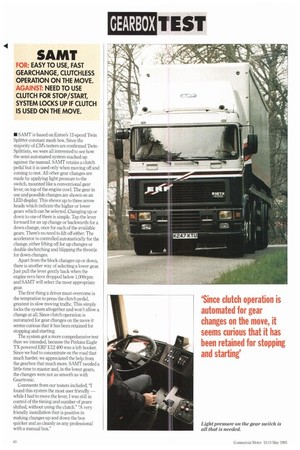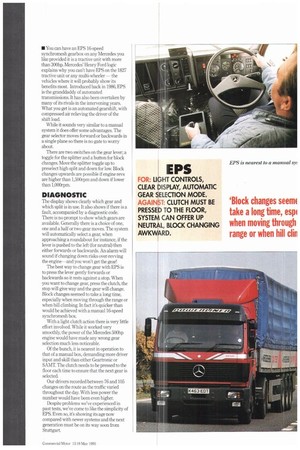GEARBOX TEST
Page 42

Page 43

If you've noticed an error in this article please click here to report it so we can fix it.
• SAMT is based on Eaton's 12-speed Twin Splitter constant mesh box. Since the majority of CMs testers are confirmed TwinSplittists, we were all interested to see how the semi-automated system stacked up against the manual. SAMT retains a clutch pedal but it is used only when moving off and corning to rest. All other gear changes are made by applying light pressure to the switch, mounted like a conventional gear lever, on top of the engine cowl. The gear in use and possible changes are shown on an LED display. This shows up to three arrow heads which indicate the higher or lower gears which can be selected. Changing up or down to one of them is simple. Tap the lever forward for an up change or backwards for a down change, once for each of the available gears. There's no need to lift off either. The accelerator is controlled automatically for the change, either lifting off for up changes or double-declutching and blipping the throttle for down changes.
Apart from the block changes up or down. there is another way of selecting a lower gear. Just pull the lever gently back when the engine revs have dropped below 1,000rpm and SAMT will select the most appropriate gear.
The first thing a driver must overcome is the temptation to press the clutch pedal, greatest in slow moving traffic. This simply locks the system altogether and won't allow a change at all. Since clutch operation is automated for gear changes on the move it seems curious that it has been retained for stopping and starting.
The system got a more comprehensive test than we intended, because the Perkins Eagle TX powered ERF E12 400 was a left-hooker. Since we had to concentrate on the road that much harder, we appreciated the help from the gearbox that much more. SAMT needed a little time to master and, in the lower gears, the changes were not as smooth as with Geartronic.
Comments from our testers included, "I found this system the most user friendly— while I had to move the lever, I was still in control of the timing and number of gears shifted, without using the clutch." "A very friendly installation that is positive in making changes up and down the box quicker and as cleanly as any professional with a manual box." • You can have an EPS 16-speed synchromesh gearbox on any Mercedes you like provided it is a tractive unit with more than 300hp. Mercedes' Henry Ford logic explains why you can't have EPS on the 1827 tractive unit or any multi-wheeler the vehicles where it will probably show its benefits most. Introduced back in 1986, EPS is the granddaddy of automated transmissions. It has also been overtaken by many of its rivals in the intervening years. What you get is an automated gearshift, with compressed air relieving the driver of the shift load.
While it sounds very similar to a manual system it does offer some advantages. The gear selector moves forward or backwards in a single plane so there is no gate to worry about There are two switches on the gear lever; a toggle for the splitter and a button for block changes. Move the splitter toggle up to preselect high split and down for low. Block changes upwards are possible if engine revs are higher than 1,500rpm and down if lower than 1,000rpm.
The display shows clearly which gear and which split is in use. It also shows if there is a fault, accompanied by a diagnostic code. There is no prompt to show which gears are available. Generally there is a choice of one, one and a half or two gear moves. The system will automatically select a gear, when approaching a roundabout for instance, if the lever is pushed to the left (for neutral) then either forwards or backwards. An alarm will sound if changing down risks over-revving the engine—and you won't get the gear!
The best way to change gear with EPS is to press the lever gently forwards or backwards so it rests against a stop. When you want to change gear, press the clutch, the stop will give way and the gear will change. Block changes seemed to take a long time, especially when moving through the range or when hill climbing. In fact it's quicker than would be achieved with a manual 16-speed synchromesh box.
With a light clutch action there is very little effort involved. While it worked very smoothly, the power of the Mercedes 500hp engine would have made any wrong gear selection much less noticeable.
Of the bunch, it is nearest in operation to that of a manual box, demanding more driver input and skill than either Geartronic or SAMT The clutch needs to be pressed to the floor each time to ensure that the next gear is selected.
Our drivers recorded between 76 and 105 changes on the route as the traffic varied throughout the day. With less power the number would have been even higher.
Despite problems we've experienced in past tests, we've come to like the simplicity of EPS. Even so, it's showing its age now compared with newer systems and the next generation must be on its way soon from Stuttgart.
































































































































